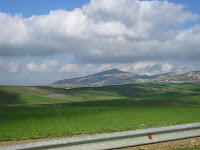
Today we went to the Roman-Phoenician site of Lixus, a few miles north of here.
It is another cold but sunny day so we eat our breakfast on the patio: hard-boiled eggs dipped in salt and cumin, Moroccan flatbread with home-made butter and stawberry jam, washed down with either lemon tea or Berber coffee.
Last night we ate very well: bissara (split-pea soup) to start, then artichokes fresh fromthe market with home-made mayonnaise, and fish that was swimming in the Atlantic that morning. A delicious tangerine and strawberry fruit-salad for dessert;strawberries are the speciality of this region and they are just coming into season.
I sat out on the terrace with Grace aftyer dinner and talked about writing. It was a cold clear night and the sky was full of stars...

Today Gentiane drives us to the town of Larache, untouched by tourism. We pass through fields of strawberries, turnips and sugarcane. The soil here is chocolate brown and very fertile. Later we see a cork forest and then the sea, as we come into Larache. After a short stop at the little archaeological museum there we visit the town souk and then the Spanish market, a covered market where we buy olives, dates, almonds and a circular white goat cheese wrapped in its own palm-leaf basket.
We stop at a shop next to a cinema; it sells sandwiches Gentiane promises will be delicious and cheap. We watch the cook chopping and frying the meat and tomatoes and onions with twin spatulas, then he pops the warm ingredients into a split piece of round flat bread and lets us choose our salad filling by pointing: onions, tomatoes, olives...
We drive out of town past the fish market, salt-pans, and marshes to a hill which rises above the sorrounding area. This is the site of Lixus. We sit in the shade of olive trees, eating our sandwiches and looking at dozens of square stone vats below us.
After we finish eating, the kind and intelligent guardian of the site tells us we have been looking at the remains of the ancient fish-salting factories. He guides us upthe hill to show us a small theatre and ampitheatre combined, a baths complex, a residential area for rich Phoenician merchants and Roman soldiers, and the remains of half a dozen temples: two Roman, two Carthaginian and two Punic... The sky is blue and the sun is warm as we go higher and higher to find a lovely panoramic view at the top.
After a good hour exploring the site we come carefully down the steep slope and reward ourselves with mint tea or coffee at the nicest cafe in Larache, overlooking the ocean...














































